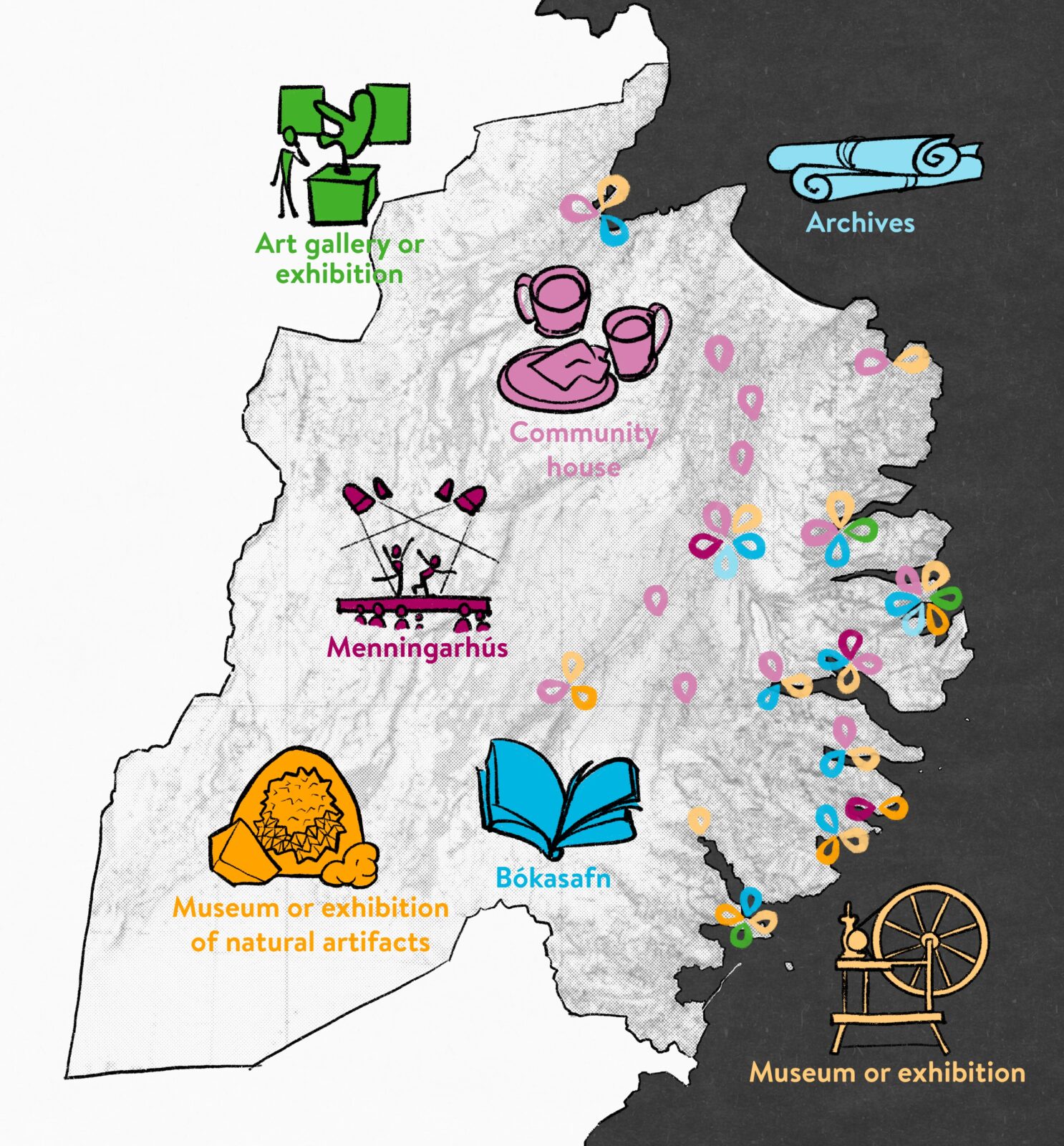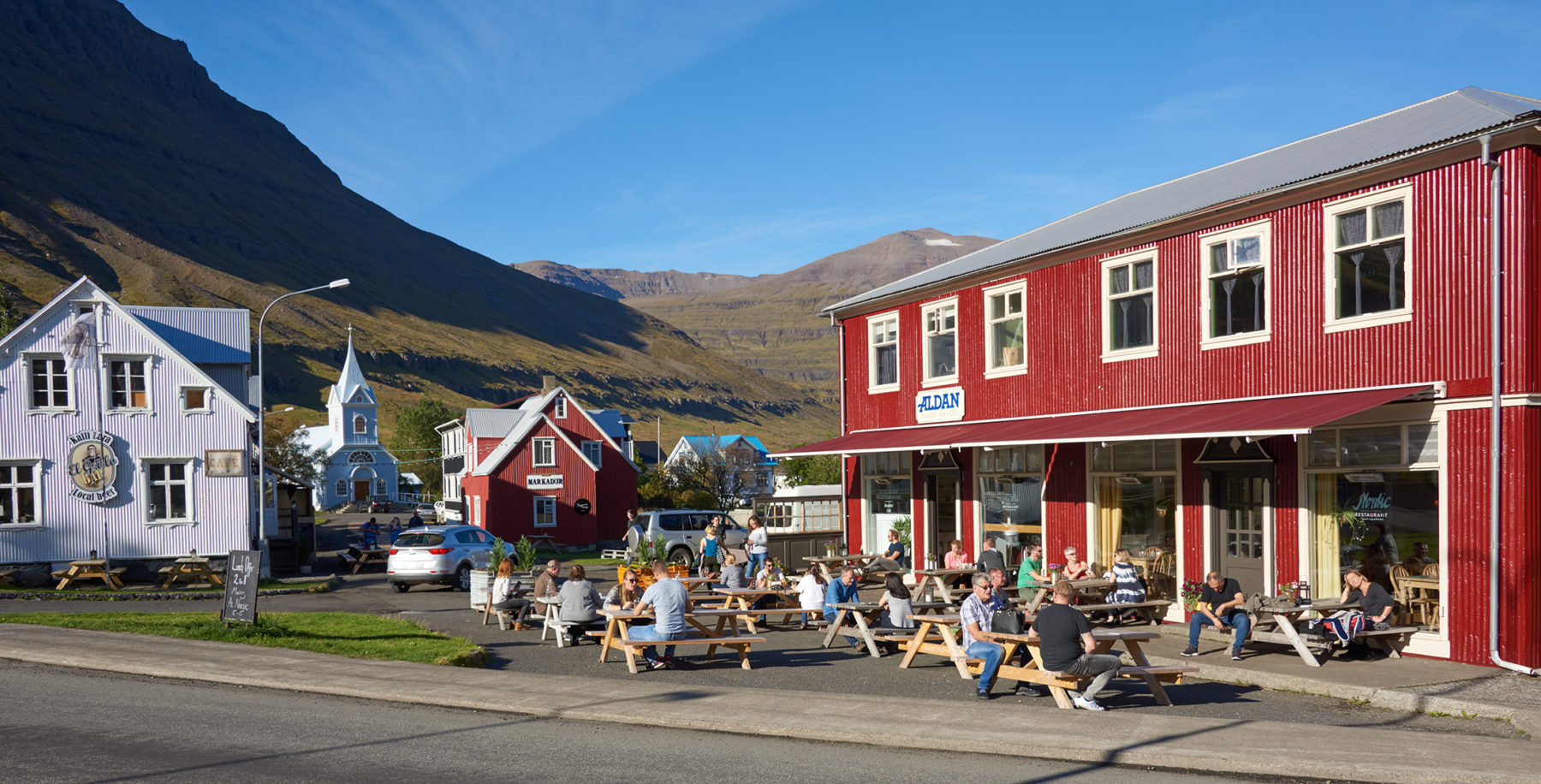6.2 Arts and Culture
Efforts will be made to nurture the local spirit and vibrant cultural life, leveraging it for job creation. Emphasis will be placed on creating an attractive and lively environment in towns that reflect a flourishing culture, strengthening cultural institutions, and supporting cultural festivals.

Ý. Strategy for Cultural Life
Ý.1 A thriving and diverse cultural life will be promoted and nurtured.
Emphasis will be placed on creating opportunities for residents and visitors to enjoy and participate in various cultural activities. Special encouragement will be given to young people and residents of foreign origin to participate and share their culture.
Focus will be on arts education, cultural literacy, and museum education at all educational levels, as well as offering art and craft courses for the general public.
Artists residing in East Iceland will be well supported and encouraged to share their experience and knowledge.
Efforts will be made to facilitate the work of artists and others who seek to work in their home communities.
Strengthening the network of artists within and outside the region and their connections with the business sector will be prioritized.
Ý.2 Cultural institutions will be strengthened.
Ways to enhance the roles of the three cultural centres defined in the regional development agreement will be sought: Skaftfell, the centre for visual arts in East Iceland, Fjarðabyggð cultural centre, and the Cultural centre of Fljótsdalshérað.
Support will be given to other cultural institutions, for example, by increasing their collaboration within the region, with other centres nationally and internationally, and through joint fundraising from the state, municipalities, funds, and companies.
Recognized museums in East Iceland will be strengthened so they can safeguard the cultural heritage of the region and meet all fundamental museum functions with dedication, i.e., collecting, preserving, recording, researching, and disseminating.
Collaboration between cultural institutions and associations in the region will be promoted to strengthen their connections with residents.
Ý.3 Cultural heritage will be utilized as a resource for job creation.
Efforts will be made to make information about the cultural heritage of East Iceland as accessible as possible for education, research, and as a source of new ideas in various creative industries and tourism.
Cultural projects that highlight or enhance interesting aspects of the cultural heritage, such as crafts and practices, will be promoted.
Research on the culture and cultural heritage of East Iceland will be encouraged (see section G.2).
Cultural tourism will be promoted (see section 4.4).
Ý.4 The availability of spaces and outdoor areas for artistic creation will be increased.
An overview of spaces and facilities that could be used for various artistic creation will be compiled, with the aim of providing this information to artists.
Emphasis will be placed on creating facilities and opportunities for art students and young artists to work in their home community during and after their studies.
Efforts will be made to provide residency programs for scholars and artists.
Ý.5 Cultural festivals and events in the region will be strengthened.
Efforts will continue to develop festivals and events for children and adults in the fields of culture and art.
Emphasis will be placed on ensuring that festivals and events take place as widely as possible throughout the region, supporting the culture, history, and uniqueness of each community.
It will be easy for both residents and tourists to learn about cultural and art events available at any given time.
Consideration will be given to residents’ access to cultural events when planning public transportation.
Ý.6 The number of outdoor art installations will increase.
Consideration will be given to the possibility of placing artworks in public spaces, such as town centres and public parks, or in well-chosen rural locations.
Competitions will be held for artworks in selected public spaces.

Explanation of the Cultural Life Strategy
East Iceland is known for its vibrant cultural life, and great emphasis has been placed on the importance of culture for quality of life and the attractiveness of the region. A strong cultural life opens opportunities for individuals to participate actively in the community, combats social isolation, and stimulates job development, including in tourism.15
Special emphasis has been placed on the participation of children and youth in artistic creation in school activities, which can enhance their broad-mindedness and social skills. Art education and creation are offered at the secondary school level, with an emphasis on art and culture as important venues for reaching and accommodating residents of diverse backgrounds.16
Three cultural centres are defined in the regional development agreement: Skaftfell in Seyðisfjörður, Fjarðabyggð Cultural centre, and the Cultural centre of Fljótsdalshérað. The East Iceland Music Centre operates under the auspices of Fjarðabyggð Cultural centre. The Gunnarsson Institute at Skriðuklaustur in Fljótsdal is an important cultural and educational centre with vibrant cultural activities year-round. The Creative Centre in Stöðvarfjörður showcases arts and creative industries in an old freezing plant. East Iceland boasts a diverse array of museums, including various exhibitions, centres, museum pointers, and four recognized museums that meet the stringent criteria of the Museum Council and operate as accredited museums under the museum laws.
All these institutions, with the recognized museums at the forefront, play a crucial role in the cultural life of East Iceland and, thus, the community. The museums preserve the cultural heritage of the region, and it is important that their facilities meet the requirements for artifact preservation. The museums also research the cultural heritage and disseminate the findings to the public in various ways. The museums are educational institutions that host school groups at all educational levels, thereby contributing to the diversity of teaching and education for children and youth. The museums are gathering places where people come together to enjoy, learn, and attend various events. They are also significant tourist attractions, providing visitors with insights into the lives and history of the people in the area.17
Municipalities in East Iceland have emphasized increasing cultural projects and jobs, better utilizing existing facilities, and improving the dissemination of information about cultural activities and the cultural heritage of East Iceland.18 It has been suggested that promotional materials and signage for artworks, buildings, literature, and the region’s history could be harmonized. It is also necessary to ensure sufficient space for the development of cultural institutions.19
In recent years, municipalities have also emphasized that the state should provide increased funding for cultural affairs in rural areas, noting that equal access to arts and culture is one of the main prerequisites for positive population development.20
To emphasize the importance of culture and the arts in the region, it is important that the built environment reflects this, with the preservation of historic buildings and quality architecture. Additionally, outdoor artworks can enliven public spaces, especially interactive artworks that both young and old can enjoy. Such an environment fosters community life and local spirit.21
The national cultural policy and its action plan outline projects that need to be followed up and that regional projects can be linked to. This could be done by developing a cultural policy for the region as a whole or by revising the cultural policy of individual municipalities, in close consultation with residents and cultural stakeholders.22

Policy on Town Centre Life
Þ.1 Strengthening the Main Streets and Town Centres of East Iceland as Service and Cultural Hubs with Attractive, Health-Promoting, and Vibrant Town Environments
Focus will be on clearly delineating town centres through environmental planning, developing vacant lots, coordinated street design, and attractive public spaces.
Ensure good connectivity between the main street and the harbour area, where applicable, as two central hubs of cultural and economic life in the towns.
The design of public spaces, such as main streets and squares, should consider various modes of transportation, accessibility for all, and the safety of pedestrians and cyclists who contribute to the town’s vitality.
The development of town centres should respect the height and size of existing buildings.
Ensure sufficient availability of suitable retail and service spaces along the main street or central area with vibrant activities, shop windows, and ground-level entrances.
Retail activities should be directed to the town centre rather than to new commercial centres away from the town centre.
Efforts should be made to increase greenery, install street furniture, and incorporate art in town centre spaces.
Avoid developing retail and service facilities on the outskirts with expansive parking lots.
Þ. 2. Enhancing the Local Identity and Specialization of Each Town Centre/Main Street:
Work on developing strong and vibrant town centres in the largest settlements where the ring road passes through, as these are also the largest towns in the area. They need to be able to accommodate many visitors and offer essential retail and services.
Highlight the unique characteristics of each settlement and work with specific themes in the design of public spaces, signage, and marketing of town centres, with historical or cultural references.
Historical buildings and structures should be well maintained, and consideration should be given to whether it is appropriate to designate protected areas in inhabited areas.
Explanations for the Policy on Town Centre Life
Thoughtful landscape and urban design can support the role of town centres as hubs for commerce and services, cultural centres, and tourist destinations.
The town centres of East Iceland are either along the main streets or in designated areas nearby. Most residents pass through the main streets daily, often by car, but with more greenery in the street spaces, artworks, small squares, parks, and other stopping points, active modes of transportation can be supported. This increases the likelihood that visitors and pedestrians will linger and thereby support local commerce and town life.
Each of the towns in East Iceland has its own history and culture that can be utilized in developing the town centres. There is an opportunity to preserve old buildings and other structures with historical significance that spark curiosity and create diversity in the built environment. Gaps in the rows of buildings in the town centres can be used for new retail and service buildings instead of directing these to the outskirts of the towns or newly developed commercial centres.
